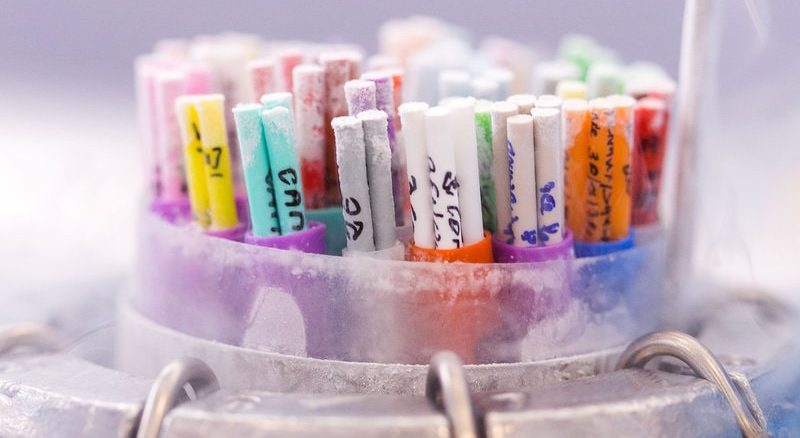Banking of gamete involves processes whereby eggs, sperm, or fertilized
embryos are stored for use in the future. This has become necessary
because of the rising rates of infertility in couples.
1. Ova/Egg Banking
Egg banking is a viable option for:
Women who want to postpone childbearing till much later in life so
they can pursue their career goals
Ladies who donate eggs to be used by couples with fertility
challenges
Women who are about to commence cancer chemo/radiotherapy and
desirous of children in the future. Chemotherapy and radiotherapy
destroy the ovaries; making egg banking a viable option
PROCEDURE FOR EGG BANKING
The procedure involves the stimulation of a woman’s ovaries with
ovulation induction drugs to produce a large number of follicles which
are then extracted, frozen, and then stored in nitrogen chambers.
The eggs are usually frozen through a process called vitrification,
which rapidly freezes the eggs. The stored eggs could be used much
later and they have a comparable pregnancy rate with fresh eggs.
Ova are usually collected for women less than 35 years of age.
When the woman or the couple decides to use the eggs, they are
thawed and then fertilized with the husband/male partner’s sperm,
and cultured in an IVF lab incubator to produce embryos.
2. SPERM BANKING
Sperm banking is a process that involves a man providing his semen in a
banking facility for use at a later date or to earn some money by donating
sperm which is sold to couples.
Sperm banks have assisted a good number of women to bear their children
in conditions where this might otherwise not be possible. It enables people
to have more choices over the issue of reproduction.
BENEFITS OF SPERM BANKING
Sperm banking is beneficial in cases where:
The man wishes to use the sperm cells later and feels he may have
challenges in the future with his fertility.
Men on treatment for cancer
Couples who need fertility treatment and the man may not be
available to provide fresh sperm cells such as in cases where couples
don’t live in the same city
Men having a vasectomy and feel they may change their mind about
having more kids in the future.
In most countries where sperm banks are allowed to operate, they are
regulated by local laws to protect the unborn child.
STORAGE OF SPERM
The sperm is stored in small containers holding less than 1ml and
preserved in nitrogen tanks. Sperm cells can be stored for more than 15
years
USE
The sperm stored in banks for commercial use can be sold to single
mothers, women whose male partners have severe sperm challenges and
recently to LBTQ couples to enable them to have children.
CRITERIA FOR COMMERCIAL SPERM DONOR
Sperm donors must be:
Healthy males between 18 to 45 years of age
Be willing to undergo frequent testing
Be willing to donate his sperm so that it can be used to impregnate
women who are unrelated to, and unknown by, him.
Must not be gay.
Free from STIs
3. EMBRYO BANKING/FREEZING
This involves freezing embryos below -198 degrees Celsius to save them for
use at a future date. It is an important part of routine assisted reproductive
programs where surplus embryos are preserved. Embryo freezing is a
viable option for the use of the embryo at a later date. This increases the
IVF success rate and reduces the cost of subsequent treatment for the
client and the risk involved with ovulation induction and egg retrieval.
BENEFITS OF EMBRYO FREEZING
It is beneficial:
If the IVF procedure fails or the IVF cycles are canceled because of
risks from the procedure
Women with cancer on treatment who are desirous of children may
also benefit from this program as cancer treatment impairs fertility.
Good-quality embryos can be frozen for as long as possible and stored for
use at a later date. The average length of time of storage is 10 years;
however, it could be longer.
The use of a frozen embryo for achieving pregnancy gives the same
pregnancy rates as a fresh embryo.
METHODS OF EMBRYO FREEZING
There are two methods of freezing embryos. They include:
1. Slow or gradual freezing in a freezer
2. Rapid freezing or vitrification
Here the embryos are rapidly frozen in nitrogen. Chemicals called
cryoprotectants are used during this process to prevent ice crystals from
forming, which could damage the embryos. It is the preferred method of
freezing embryos.
Embryo freezing is relatively safe and often leads to a successful
pregnancy and delivery. However, some of the embryos may get damaged
during thawing and there may be the possibility of a slightly higher chance
of genetic abnormalities in the children born from it. It is still a developing
field and more research is still ongoing about its safety.
If you’re considering embryo cryopreservation, talk to your gynecologist
or fertility specialist for further information.

